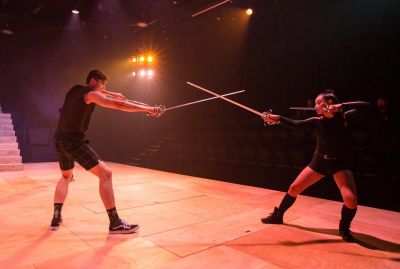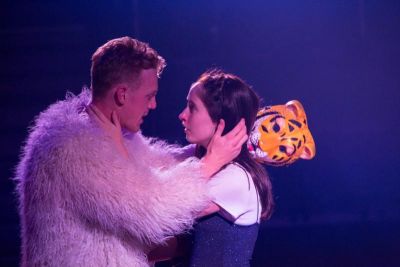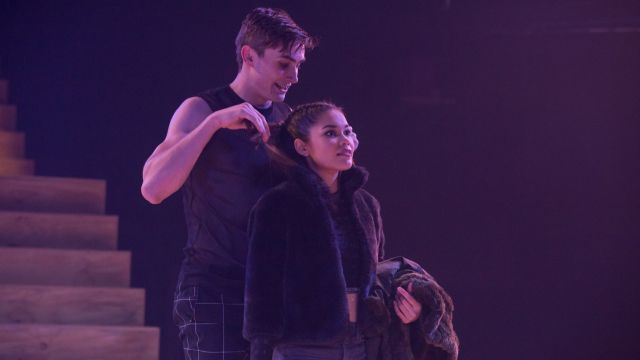Romeo and Juliet
Ongoing creative collaborators, La Boite and QUT Creative Industries are presenting an expurgated version of the Shakespearean tragedy that runs a mere 1 hour 45 minutes without interval. All the vital speeches are still in there, but many scenes are cut short or cut out altogether, making for a leaner script that gives the director Todd MacDonald more room to play with movement and silence.
This is a visually stunning piece of art. MacDonald shows directorial brilliance and wonderful use of the Roundhouse space. His next-level vision and concepts are supported by outstanding set design by Anthony Spinaze.
Around a dozen trap doors in the pale wooden flooring are used so imaginatively; they’re entrances and exits for cast, graves in the churchyard, and the portals through which set pieces are brought into and out of the space. A towering staircase from the same pale wood climbs one side of the Roundhouse, making the stage a thrust for this show. This gives the performers and director plenty of levels on which to play. The raised flooring also adds to the intimacy of La Boite’s space, that already places the audience close to the actors.
 MacDonald has chosen to make a huge commitment to the ‘love at first sight’ interpretation of the play. The meet cute and subsequent scene between the lovers (Act I, Scene V and Act II, Scene II) use a combination of music, silence, slow motion, lighting and set design to dial the romance up to 11.
MacDonald has chosen to make a huge commitment to the ‘love at first sight’ interpretation of the play. The meet cute and subsequent scene between the lovers (Act I, Scene V and Act II, Scene II) use a combination of music, silence, slow motion, lighting and set design to dial the romance up to 11.
The choice to use modern garb and music enhances the relatability for the audience, yet you still feel this tale is not of our time. Although it’s cut, there’s still a lot of respect given to Shakespeare’s text, so you don’t feel like it’s a gimmicky modernisation.
It’s not uncommon to see the star-crossed lovers outshone by the acting skills of the more mature members of the cast in this play. This is the case for Romeo (Jack Bannister) who does leave one somewhat wanting for a more convincing, emotionally motivated performance. His dialogue often feels rushed and the histrionics lacking in meaning.
That’s not to disparage all of the young players. Some do show great skill. Grady Ferricks-Rosevear (Mercutio) is physically exciting to watch. He has amazing acrobatic skill and is especially emotionally moving when his character curses both houses during his demise.
 Darcy Gooda plays the part of Juliet as a jazz musician plays a trumpet. She delivers lovely, unexpected notes that make perfect sense when you hear them. She shows charming vulnerability and also brings the physical awkwardness and speech patterns of a naive teenage girl to the role.
Darcy Gooda plays the part of Juliet as a jazz musician plays a trumpet. She delivers lovely, unexpected notes that make perfect sense when you hear them. She shows charming vulnerability and also brings the physical awkwardness and speech patterns of a naive teenage girl to the role.
It’s just that the mature performers are so good you do see a contrast in abilities. Kerith Atkinson (Capulet) and Colin Smith (Montague/ Apothecary) are brilliantly adept at emotionally interpreting the text for a modern audience. You believe and understand every word they say. Eugene Gilfedder’s (Friar Laurence) perfectly paced, clearly enunciated dialogue and terrific focus make him captivating. These are actors truly inhabiting their characters. Their verbal command of the work is matched by exceptional physical discipline.
Bridget Boyle (Nurse/ Prince) is arguably the star of the show. The audience loves everything she does. She brings so much comedy, warmth and nurturing to the Nurse role, contrasted with command and poise in the role of Prince. Her interpretation of the meeting of Nurse and Mercutio and the subsequent quizzing of Romeo about his friend brings the house down (Act II, Scene IV). The scene between the Nurse and Juliet (Act II, Scene V) wherein the Nurse delivers news that Romeo does intend to make her his bride is a pure joy to behold. It’s visually reminiscent of a Pre-Raphaelite painting, but the joy lies in the comfortable, affectionate relationship between Nurse and Juliet.
 Anna Whitaker’s sound design is cinematic. One example being the sound effect in the churchyard scene (Act V, Scene III), which compounds the emotional impact felt by Romeo when he sees Juliet’s prone figure.
Anna Whitaker’s sound design is cinematic. One example being the sound effect in the churchyard scene (Act V, Scene III), which compounds the emotional impact felt by Romeo when he sees Juliet’s prone figure.
Nigel Poulton’s fight direction is part dance, part stage fight. It’s thrilling to watch, as too are the dance sequences. The actors throw themselves into all of the movement with abandon. This is a cast that’s well-rehearsed and trusting in one another.
It’s always a challenge to bring something new and interesting to Shakespeare’s work; especially a play as well-known as Romeo and Juliet. This production succeeds in delivering an artistically gorgeous, visually memorable and truly romantic interpretation.
Kiesten McCauley
Images by Stephen Henry.
Subscribe to our E-Newsletter, buy our latest print edition or find a Performing Arts book at Book Nook.

